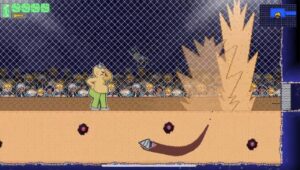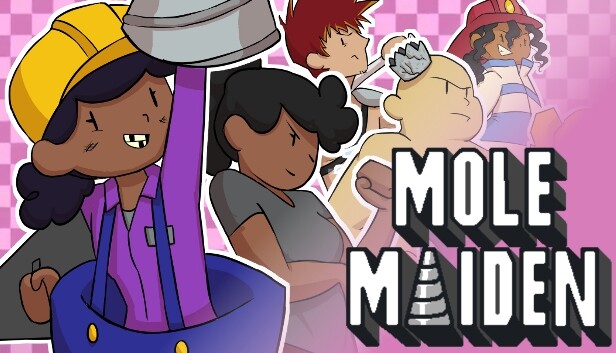We all know the authors of our favorite novels, but do you know the writers of your favorite video games? Though not often acknowledged as a form of literary narrative like creative writing, filmmaking, playwriting and journalism, gameplay is still a form of storytelling. If done well, through thoughtfully-crafted game mechanics, fully fleshed characters and an engaging plot, a game can be just as immersive as a book, film or play of the same type.
Earlier this month, I had the honor to connect with recent Miami University graduate and indie game developer, A.J. Fulco. Though he didn’t study English, it was his love for the arts and storytelling that led him to write and develop video games. During his early childhood, Fulco dabbled in all different forms of art, from choir to filmmaking to comics, and initially wanted to be a cartoonist. But in fifth grade, he discovered that he could make his own video games and found his true passion: “What I found from learning about video game development is that it lets you use every type of artistic discipline. You get to make something that’s not only passive, but also interactive”. Now, for the last two years, this love for interactive storytelling has lead to the creation and development of his first major game, Mole Maiden: an action-adventure game that follows the journey of a young girl, Penny, as she leaves home to explore and fight opponents in her underground mining hometown in order to claim the title of Burrow League Champion. Fulco graciously agreed to sit down with me and tell me about his inspiration and writing process for game development, as well as share some advice for any other young artists who are curious about creating their own games.
The Inspiration: Senior Capstone Turned Demo Game
As an undergraduate at Miami University, A.J. Fulco was in a game development program where every month he was required to create a new game prototype. During the semester leading up to his senior capstone, he was assigned to create a game with a player character who “moves like water.”
The initial idea for Mole Maiden was inspired by the mechanics of a certain scene within Ori and the Blind Forest, another adventure platformer game with very fluid controls that allows the player to have a lot of influence over the way their character moves throughout the world, and especially within water.
Intrigued, he tried applying these water-like mechanics, except instead of moving through water, his player character Penny could move fluidly in all directions by literally drilling through the ground. By the time that he finished the prototype, Fulco was fascinated with the idea of a ground-based game, and dedicated his senior capstone project to developing his prototype into a demo.
Story First or Story Out of Mechanics?
Within a more traditional narrative genre, an author may begin their storyboarding process by analyzing one of their characters, their strengths and flaws, and creating from that a setting and plot which challenges, develops, and enriches them. However, this is not the case for writing gameplay, especially that centers around action and exploration.
Fulco notes that a lot of the joy that people have within games come from how the environment tells a story so, he approaches game development the same way in which Nintendo does: “to build the game first and then the story around the mechanics you made.”
In the case of Mole Maiden, the game narrative all boils down to the fluid drilling mechanics that Fulco had spent a month creating. From there, he could develop the world where these mechanics made logical sense. Naturally, drilling mechanics would fit nicely into the setting of an underground cavern town; but how could these two aspects of the game come together to advance the plot? In order to make any game enjoyable, a player has to overcome some sort of challenge. Perhaps then, the player is encouraged to explore this cavern, yet along the way, they come across not only blockades, but also monsters and people who want to prevent them from exploring any further in the cavern; what would they do then? This is where the drilling mechanics can double as the player character’s powers. Then, of course, the characters all fall into place. Maybe these other people have other powers based off of specific parts of the cavern, such as underground waterfalls, lava lakes or even a bat cave. Maybe, this mining town should have a league of fighting champions and a young, spunky protagonist who wishes nothing more but to train hard so claim their titles for herself.

When writing for games, a game developer isn’t so much writing a script as a collection of scenarios that happen at key points within the game. In order to connect these scenarios together to create an immersive interactive story, a developer has to consider elements of the game that are consistently revisited: character interactions, adventuring, or other elements of the game. In doing so, they piece together this grander narrative that would be much more tedious to portray through lengthy cutscenes like within a role-playing game or through backstory within a book.
More than anything, Fulco wanted the experience of playing Mole Maiden to be an exploratory narrative about a young girl following her dreams: “I wanted to make a world that was seeping with personality and quirkiness: something that was a bit more about the journey and the characters you meet along the way. There are some stretches of the game where there are no enemies, or if there are, they’re very small, easy-to-defeat enemies that are a little off the beaten path to provide just a small bit of challenge here or there. But ultimately, there are more characters that you can talk to.” Through these characters, Fulco builds the world of Mole Maiden, combining fights with character interactions within the R&D Mine until Penny eventually makes it to the final stage to defeat the final boss.
The Certification Process
Although the process of game development can be very involved, the writer’s work isn’t over when the game is playable. One of the hardest final challenges for a game storyteller is the publication process. For novelists, this process involves pitching their story to publishing houses. But for game developers it’s having their games certified. In order for a game to become certified, it must meet a set of criteria before it will be allowed to be released. While this majorly includes checking for major bugs or coding issues, certification also concerns how well the game will sell once it releases. Additionally, the certification process varies depending on the platform on which a game developer wants their game to appear. “This will be my first commercial platform launch outside of Itch, and I’m kind of learning as I go along.”
Though it comes with its struggles, uploading a game to computer platforms seems to be easier than uploading a game to console platforms. Fortunately, Fulco had a head start, as his graduating class was offered a $100 scholarship which would cover the fee to feature a trailer and demo for Mole Maiden on the popular gaming platform Steam’s store page. Following that, however, there were several factors he had to follow through to assure that his final game could do well once certified, which includes promoting the game. The goal of these efforts is to get your game onto player wishlists. “Wishlists are almost like your estimated conversion numbers for how many sales your game would make. I’m very fortunate that I made the decision to make the store page right after I got out of school and started to work on the fuller game, because having that scene page up as soon as you can is very important.”
Thankfully, after this, though, the process is fairly straightforward. A game developer will want a group of test players to complete the game and report any bugs or issues. Once no major bugs are found, the game can be sent to Valve, a mass gaming service, who will complete a certification process. If approved, a game developer is then able to press launch and release their game.
In order to release a game onto a console platform there are a few more steps, though. Firstly, there’s an ESRB rating, which rates what age group your game is appropriate for and, secondly, some consoles have specific standards that your game must meet in order to be uploaded, such as a controller disconnect screen.
In early April, A.J Fulco announced that there are no plans to upload Mole Maiden to console platforms. As for computer platforms, there is no set release date, however, according to his latest newsletter, Mole Maiden entered the Alpha-4 stage of development: the stage where all final changes to stages and characters are made before being tested for bugs.
Final Sentiments and Advice
Fulco’s biggest piece of advice is that if you want to make game development your career, the first thing you’ll have to do is moonlighting, which essentially means having a part time job in the morning and work on your game at night. Although not ideal at first, the reality of having a creative job is that you’ll have to spend money to make money. In order to make connections with other game developers and video game companies and promote their game, a game developer has to attend conferences and conventions and buy store fronts and assets.
Secondly, he advises to not be afraid to show off your game. Prototype your stuff and have it tested by as many people as soon as you can: “you don’t want to spend a bunch of time making a game that nobody wants. Have people play your games, and watch their reactions.”
Most of all, “if you want to be an author, recognize that games are an option for you to take in your career and don’t limit yourself to a specific medium.” If you have a passion for a specific art, pursue it in every medium, and be as flexible as you can. If you’re wanting to be a part of a certain art, do it and take yourself seriously.
“Be flexible, optimistic and take every opportunity you can get.”
***
Did you enjoy this piece and can’t wait for Mole Maiden?
Click on the logos below to check out the demo on Steam, join the official Discord server and social media pages for updates on the full game:





I really enjoyed reading this! There is so much to game development that people may not consider, and it was fascinating to understand the process of how the game was made and inspiration behind it. The ending was also very inspiring, I loved the message you conveyed with this article. Amazing job, as always!
People do not talk about how much it truly takes to develop a game. This post truly brought light to everything that it takes! I will definitely be keeping an eye out on Fulco’s game! Keep up the great work!